
Audi Q5 Review, Specs & Pricing

Introduction
Audi offers a model to fill any niche. Need a large coupe but want four doors and a boot? The A7 will work nicely. Want an enormous SUV but don’t feel the need for practicality? The Q8 will serve you fine. Desperately want a Ferrari but you’re a £100,000 short? Take a look at the R8.
And then there’s the Q5 that we’re testing here. It’s a medium-sized SUV that doesn’t do anything unusual at all. It’s got five doors, a decent amount of space, is economical enough and doesn’t cost a huge amount. It’s as conventional as an Audi gets.
Given that Audi hasn’t forgotten how to make a fine car, could this all-thing-to-all-men model be the best Audi of them all?
Select's rating score* - 4.3 / 5
At a Glance
With five SUVs in its range, Audi has had some time to practice and get this second-generation Q5 right. Inspired by its bigger brother, the Q7 behemoth, it’s reduced to a more manageable size by having the third row of rear seats cut out. This is, therefore, very much a five-seater and those looking to carry more people need to look elsewhere.
It’s got that distinctly Audi front end, a six-sided grille dominating the rearview mirror of whatever is ahead of it, with huge air intakes to the side that may or may not do anything, and fairly conventional headlights alongside with some complex LED daytime running lights.
But, somehow, it’s softer than the regular Audi. That might be to do with the colour my car is in, a rather dull dark blue, but it’s refreshing not to have such aggression being projected ahead of you. The same holds true as you walk around the car, with soft, sculpted sides gently curving their way to the rear. Conventional tail lights, a big rear window and no silly exhausts suggest this could be a proper and practical family car.
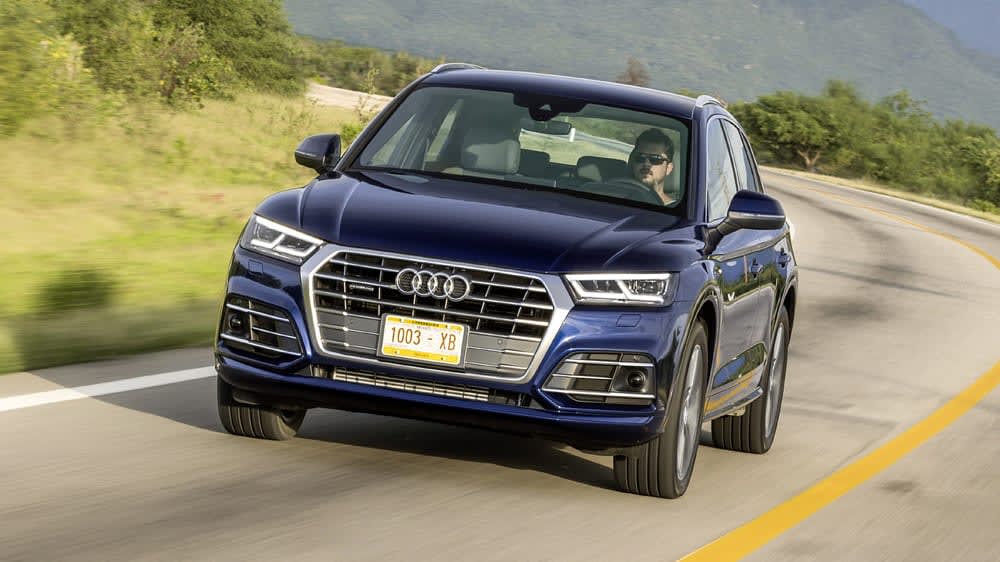 As you would expect. There’s a range of engines available, from diesel and petrol options to a plug-in hybrid, and an array of trims that make little sense, but there's ultimately a model for everybody. And if that fails, there’s a lengthy options list.
As you would expect. There’s a range of engines available, from diesel and petrol options to a plug-in hybrid, and an array of trims that make little sense, but there's ultimately a model for everybody. And if that fails, there’s a lengthy options list.
A model for everybody also includes the enthusiasts as, despite the soccer-mom sensibilities of the Q5, there’s a hot, sporting model powered by a 3.0-litre… diesel?
Key Features
When there’s something as conventional as the Q5, there are few stand-out features that attract attention. However, that’s not to say it’s lacking in any way - everything that’s fitted to the car might be similar to tech that exists elsewhere, but it's been refined and improved just enough to stand out in its own right here.
Even the Q5’s real standout feature, its all-wheel-drive system, is overlooked by many as its name has become so ubiquitous. Quattro might be a word the more mature of us associate with fire-breathing rally cars flying through forests but, to many, it’s just another badge on the back.
If you think that, you’re missing out. The quattro system adds stability and control, improving traction to create a car that feels surprisingly agile while also offering reassurance that foul weather or unpredictable surfaces won’t affect the safety of the car - or those inside it.
And you might think much the same when looking inside the car, that it’s just a conventional car with little to shout about. Do that and you’re missing the rock-solid build quality and the reassurance that should offer you for the vehicle's longevity. It’s rare for an Audi to hide its best bits, but it looks like the Q5 might have more to offer than a first glance indicates.
Performance & Drive
Audi’s insane engine naming system means the range starts at 40, which is a 204hp diesel model, goes through 45 (petrol), 50 and 55 (plug-in hybrids) and finally reaches SQ5, which is a 347hp diesel.
Until recently, most would have plumped for the 40. That benefits from a 2.0-litre turbocharged diesel engine that produces enough power to be more sprightly than you might expect, while providing some very real economic benefits. It can be a bit slow pulling out of junctions while you wait for both the turbocharger to spin up and the gearbox to decide which gear it’s going to use but, once those two have had their discussions and got things sorted, it’s rapid enough to get you into trouble.
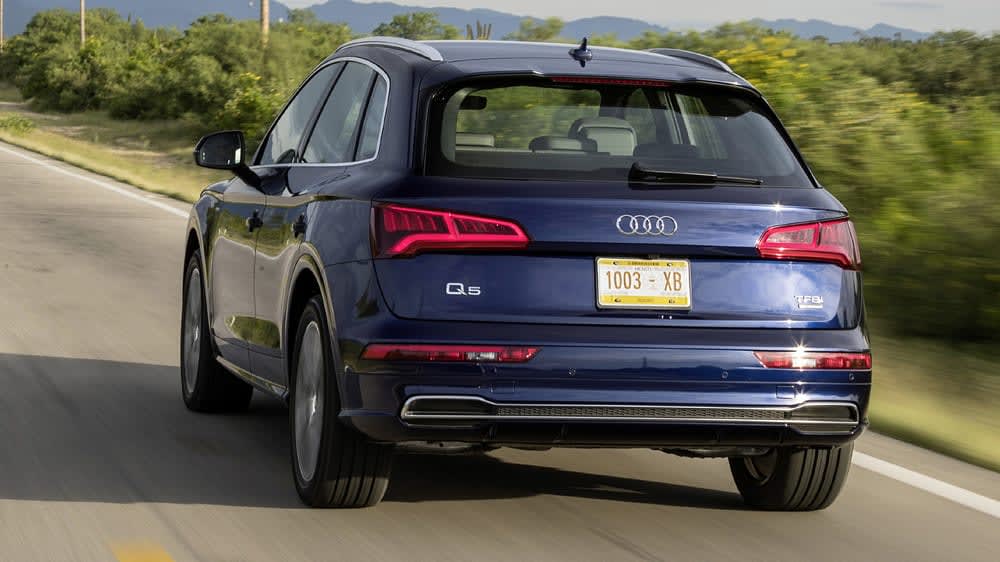 However, for very little extra monthly outlay, the plug-in hybrid offers many advantages. Most are financial, admittedly, but with up to 367hp available, the planet-saving part-petrol, part-electricity 55 TFSI e is only 0.2 seconds slower to 62mph than the SQ5.
However, for very little extra monthly outlay, the plug-in hybrid offers many advantages. Most are financial, admittedly, but with up to 367hp available, the planet-saving part-petrol, part-electricity 55 TFSI e is only 0.2 seconds slower to 62mph than the SQ5.
With straight-line bragging rights sorted, the tricky issue of the ride and handling needs dealing with, and, again, it’s not clear cut. Most models ride on conventional steel springs, which are fine but a little firm on urban roads especially. Grip levels are good but push to the edge and it's not particularly involving.
High-grade Vorsprung models get a sophisticated air-suspension system, and this is markedly better. There’s increased agility, and it’s more capable of absorbing those long undulations on the motorway, leaving the Q5 as one of the finest riding cars in the class.
Well, almost. The Vorsprung model also comes with 21-inch wheels and rubber band tyres, which means every single surface crack or expansion joint in the road surface thumps its way into the cabin.
Running Costs
Strong residual values keep leasing costs quite low, making the Q5 a surprisingly affordable choice. Those choosing the petrol-powered models might get a shock with economy, as official figures of around 32mpg are a reminder that SUVs are heavy and potentially thirsty. The diesel 40 model fares much better, promising as much as 43.5mpg.
It does fall into the highest BIK band though, so company car drivers will be facing a tax bill based on 37% of the list price.
That can be solved by looking at the plug-in hybrid which, even in 55 spec, has an official economy figure of 117.7mpg. This is, obviously, crazy but it is possible; with up to 27 miles of pure-electric range, an ‘average’ days motoring might just be possible without using a drop of fuel. Even allowing for an optimistic range figure, a 50-mile day means 20 miles on pure electric and only 30 using petrol power.
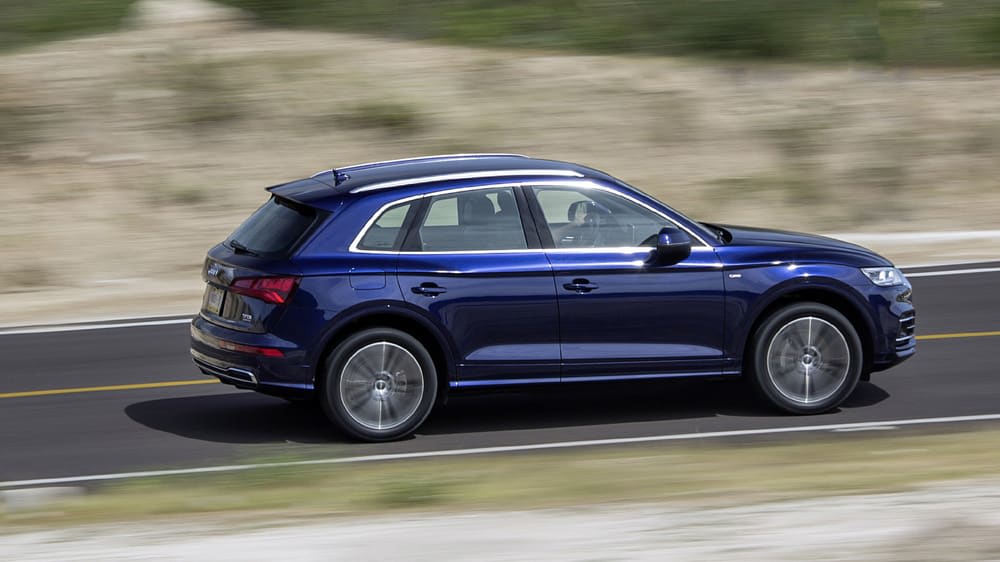 Company car tax rates drop, too, with the BIK burden plummeting to 14%. IT might be more expensive to lease than the diesel, but the tax bills are slashed.
Every Audi has a two-year, unlimited mileage warranty. That’s topped up to a third year, but with a 60,000 mile limit on. It’s possible to upgrade that cover to as much as five years, but at a price.
Company car tax rates drop, too, with the BIK burden plummeting to 14%. IT might be more expensive to lease than the diesel, but the tax bills are slashed.
Every Audi has a two-year, unlimited mileage warranty. That’s topped up to a third year, but with a 60,000 mile limit on. It’s possible to upgrade that cover to as much as five years, but at a price.
It’s also possible to pay a few hundred pounds for a service plan, effectively pre-paying for the next two services. With annual servicing, that might just see you through to the end of a lease.
A heavy SUV and a relatively small engine mean emissions won’t be great. The diesel models start as low as 165g/km of CO2, while petrol models emit more, with a figure from 191g/km. The model range peaks at 224g/km, which is what the SQ5 produces.
The plug-in hybrid models are, as you would expect, far better, with a range from 55-61g/km, depending on the specific trim and power options chosen. Emissions have been improved by the use of AdBlue, so you’ll need to factor in an occasional refill of the tank, estimated at around 9,000 miles.
First-year vehicle tax rates are fairly high because of those figures, while every model attracts the DVLA’s bonus £325 annual tax bill for being worth more than £40,000, making the annual tax bill £465. At least the hybrid models get a £10 discount on that…
Interior
There are few interiors better than those you’ll find in an Audi. They may not be the most exciting, with a Mercedes offering a far more glamorous design, but they exude quality and work well ergonomically. The Q5 is no exception, representing peak Audi quality, too. Every touchpoint feels solid, every switch is damped perfectly, and every knob rotates with just the right level of resistance. Everything else feels like it’s been hewn from granite, then covered with soft plastics or leather. You’d be happy with the perception of quality on a car costing five times this. Really.
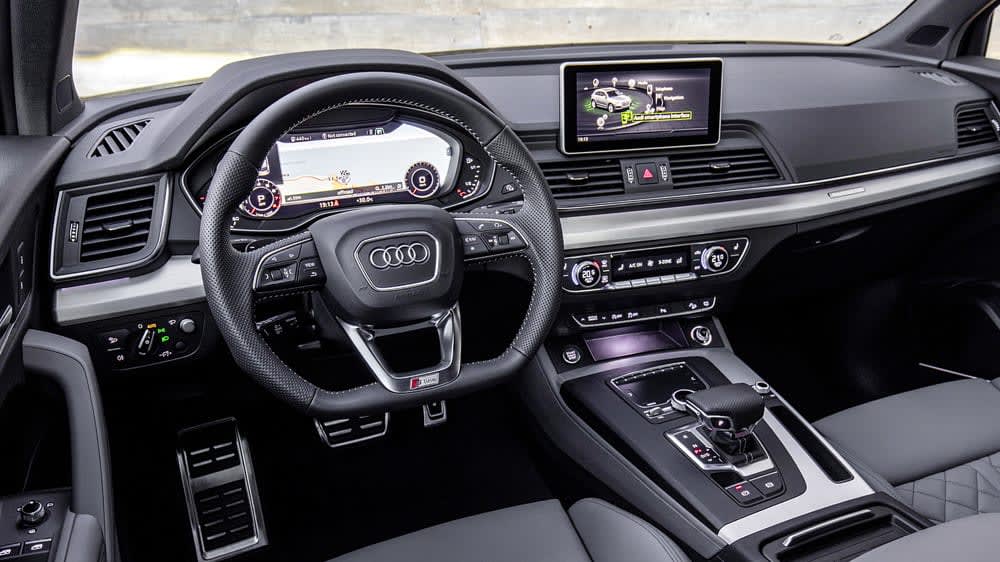
It’s a well thought out cabin that will work perfectly for individuals or families, too. A clear instrument panel sits ahead of the driver, made even clearer if the digital Virtual Cockpit is fitted. That replaces the traditional dials with a fully customisable digital screen, so you could have a speed readout over a Google Earth map used for navigation.
The rest of the dashboard is conventional, and includes plenty of buttons - that’s a good thing, as it means you don’t need to go hunting through the infotainment system to find the feature you need.
At the very top is the 10.1-inch infotainment screen that looks like it’s been glued on as something of an afterthought. Still, it’s close to your eye line and clear to read. The controls are down by the gear selector, with a touchpad, dial and switches combining to create a complex interface that, with practice, is as easy to use as anything else.
Pick the popular S line trim and there’s enough technology included to put PC World out of business. Most, as ever, revolves around the infotainment centre that allows control over most of the car’s functions.
Of course, there’s a DAB radio, Bluetooth connectivity and satellite navigation. That’s kept updated for 36 months and includes European coverage. Smartphone mirroring is also included, with Android Auto and Apple CarPlay allowing you to use the features of your phone you're familiar with. Higher trim levels add Bang & Olufsen sound systems to the mix, as well as a wireless charging pad for a smartphone.
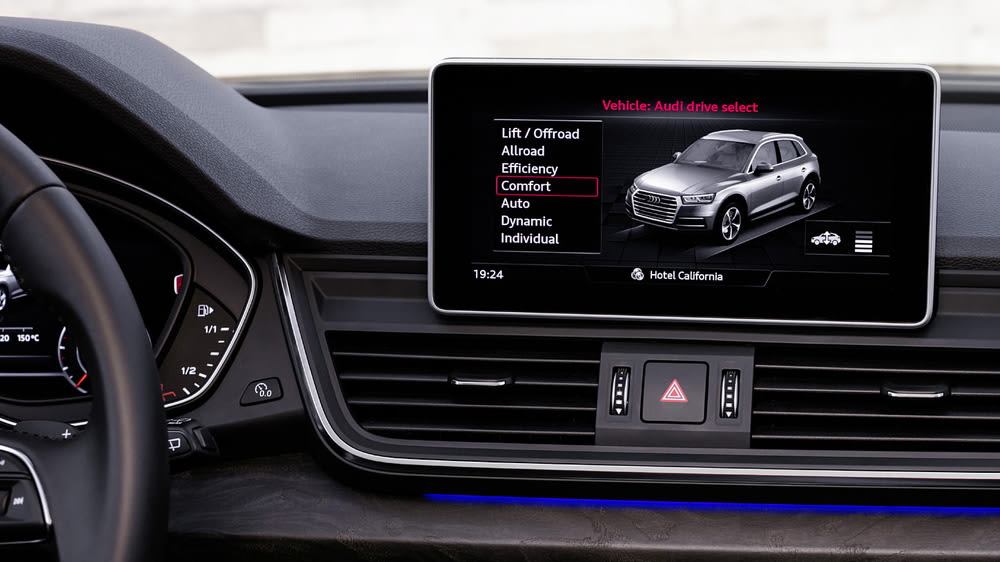
The Virtual Cockpit is added to S line cars, providing a fully digital instrument panel that can be customised to suit individual needs; relax with a minimalist display showing little more than your speed, or get all of the information from economy, navigation and music displayed on there, as well as extra dials and satellite imagery.
Practicality & Boot Space
There’s good and bad about the Q5’s offering. Front seat passengers will be more than happy with their accommodation, with supportive seats that slide, tilt, lower and raise into a position guaranteed to be comfortable. The tall SUV roofline ensures good headroom, too.
Those in the rear get a good deal too, but only to a point. There’s plenty of head and legroom (although the very tallest will be better served in a Volvo XC60) but there’s only enough for two; opt to squeeze three passengers in the back and you’ll find one of them unhappy with their lot, thanks to a raised seat cushion and intrusive transmission tunnel. Splash out on the Vorsprung model, or tick the option on lower models, and you can have rear seats that slide and recline, offering increased comfort for passengers.
While the Land Rover Discovery Sport can squeeze in a sixth and seventh seat, albeit tight ones, there’s no option to extend the Q5 into being a seven-seater. That does result in a decent size boot though, as there’s no need to hide any extra seats anywhere.
That leaves 500 litres of storage behind the electric tailgate, which is exactly what you’d get from many of the Q5’s rivals. It’s a usefully square shape, too, so you’ll probably get more items in the Audi than you will in the Land Rover or Volvo.
Safety
Euro NCAP tested the Audi Q5 back in 2017 where it scored a full five-star safety score. Apart from looking after its adult occupants well, as you would hope for, it scored particularly well for its protection of children within the car.
Countless airbags and restraint systems keep everyone in place in the event of an impact, but there’s a suite of equipment installed to prevent that happening in the first place. Chief amongst those is Audi’s Pre Sense City. That’s a posh name for automatic emergency braking, which operates at speeds of up to 52mph and does all it can to avoid or, at least, minimise any impact.
There’s also blind-spot monitoring, sensors that check for crossing traffic at both the front and rear of the car, and a pre-sense system that works on rear impacts. However, check specifications carefully as not all items are fitted on every model.
Options
Despite being relatively well equipped as standard, it’s easy to state racking up serious bills from ticking boxes on the options list. Despite there being several trim levels available, it's S line or Vorsprung that you want to be heading towards initially. S line offers a nice balance, offering all the essentials and not skimping on anything, but the Vorsprung trim level adds every conceivable piece of equipment.
For S line models, the £1,250 Tour Pack adds adaptive cruise control and some extra safety equipment, such as lane-keeping assist. A £225 Storage Pack adds extra nets in the rear and boot, some cupholders and a few extra cubby holes, which might be worth it for families.
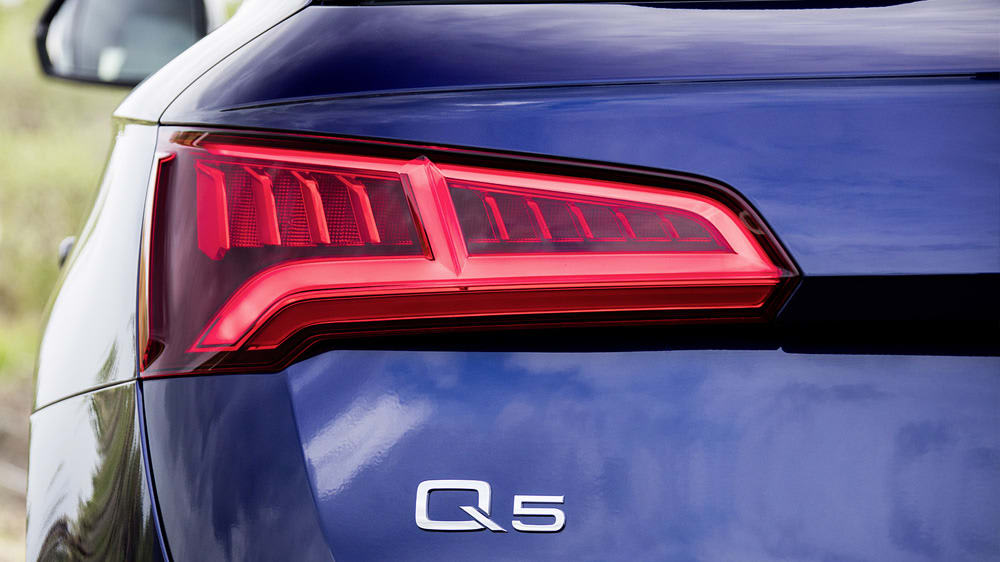
Audiophiles could be tempted into splashing out £1,395 for the Bang & Olufsen sound system. This brings 3D stereo surround sound and 19 speakers to the mix, replacing the eight-speaker system fitted as standard.
Adaptive air suspension is available at £1,700 which improves the ride, but it’s not bad to start with, Your money is probably better spent elsewhere
Who Rivals The Audi Q5?
Every premium manufacturer has a rival for the Q5, and some of them are excellent. However, there are some mainstream rivals that bring just as much ability without the price tag; be brave and consider the Peugeot 3008, for example.
If that’s a step too far, the BMW X3, Jaguar F-Pace, Land Rover Discovery Sport, Lexus NX, Mercedes-Benz GLC and Volvo XC60 will do the trick. The Volvo is the most understated and brings a Swedish minimalist charm with it. It’s spacious, refined and safe, but not as refined or engaging as the Audi. The Lexus is an interesting option, packed with Japanese technology, but it’s a little outclassed in this company, as is the Jaguar F-Pace.
The Mercedes has a more dramatic presence and makes the driver feel rather special, but it’s all show - it’s not quite as capable as the Audi, nor as comfortable or engaging.
The Land Rover is a more practical proposition, especially if you need the four-wheel-drive ability. Two jump seats in the back add some practicality for an impromptu seven-person expedition.
Finally, the BMW X3 is every bit as good as the Audi. Deciding between the two will come down to personal preferences but, at a push, the X3 is slightly better to drive and the Audi is slightly better to relax in.
Verdict & Next Steps
You might expect the Volvo XC60 to be the model to go for in this segment, the Swedish firm always managing to come up with something that straddles the fence between overtly sporting and boringly comfortable.
However, Audi has taken the middle ground and made it its own. And that middle ground isn’t negative space as, with rivals as capable as you find in this segment, you need to excel in every single area to stand out.
The Q5 excels in almost every area - it’s not a real SUV in that it won’t venture far off-road, but it’s as comfortable, as spacious, as refined, as sporting and as affordable as any of its rivals.
Lease price: from £380.39
Read more on the latest SUV lease options: Take a look at our Volvo XC90 Review 2020 and check out our new Land Rover Discovery Sport Review.
*Score based on Select’s unique meta score analysis, taking into account the UK’s top six leading independent car website reviews of the Audi Q5.
**Correct as of 06/10/2020. Based on 9 months initial payment, 5,000 miles over a 48 month lease. Initial payment equivalent to 9 monthly payments or £3,423.49 Ts and Cs apply. Credit is subject to status.



















